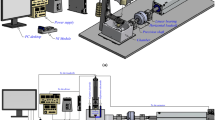Abstract
The concentric ring test has been proposed as the preferred method for testing the flexural strength of bioceramics. If the apparatus used for such tests is proved to be reliable and accurate, it may be adapted to enable cyclic fatigue testing. However, before such adaptions are made, it is necessary to ensure the apparatus operates satisfactorily. The assessment programme involved strain gauge and finite element analyses of both an advanced titanium alloy (IMI 834) and 3 mol% yttria-stabilized zirconia disc specimens and preliminary fatigue tests on IMI 834 discs. The results of the analyses indicate that concentrically loaded discs are exposed to peak biaxial stresses on the tensile surface of the specimen and that these stresses are uniformly distributed within the peak loaded region of the disc. The fatigue response of IMI 834 discs under concentric loading was similar to that under uniaxial tension and torsional loading. The success of this programme will now enable fatigue tests on bioceramic discs to be performed with confidence in the reliability of the test apparatus.
Similar content being viewed by others
References
“Standard Test Method for Flexural Strength of Advanced Ceramics at Ambient Temperature”, ASTM C1161-90 (American Society for Testing and Materials, Philadelphia, PA, 1990).
ISO/TC 150/SCI, Draft International Standard, “Implants in Surgery — Ceramic Materials Based on Yttria-Stabilized Tetragonal Zirconia” (1996).
M. N. GIOVAN and G. SINES, J. Am. Ceram. Soc. 62 (1979) 510.
T. THIEMEIER and A. BRUCKNER-FOIT, ibid. 74 (1991) 48.
L. CHAO and D. K. SHETTY, ibid. 74 (1991) 333.
U. SOLTESZ, in “Proceedings of the 2nd International Symposium on Ceramics in Medicine”, Heidelberg, Germany (1989), Bioceramics 2.
U. SOLTESZ, H. RICHTER and R. KIENZLER, in “High Tech. Ceramics”, edited by P. Vincenzini (Elsevier Science Publishers B.V. Amsterdam, 1987) p. 149.
B. J. HULM, J. D. PARKER and W. J. EVANS, in “Proceedings of the 11th Irish Materials Forum Conference”, “Key Engineering Materials”, edited by P. E. McHugh (Transtec, Switzerland, 1996) p. 321.
E. J. HEARN, in “Mechanics of Materials”, Vol. 2, (Pergamon, Oxford, 1985) p. 636.
I. N. SNEDDON, Proc. R. Soc. Lond. Ser. A 187 (1946) p. 229.
A. C. PICKARD, in “The Application of Three Dimensional Finite Element Methods to Fracture Mechanics and Fatigue Life Prediction” (Published by Engineering Advisory Services Ltd., Warley, U.K., 1986) p. 89.
J. R. RICE, in “Fracture: Mathematical Analysis of the Mechanics of Fracture. An Advanced Treatise”, Vol. 2, edited by H. Liebowitz (Academic Press, New York, 1968) pp. 19–311.
W. J. EVANS and M. R. BACHE, in “Proceedings of the 8th World Conference on Titanium”, edited by P. A. Blenkinsop, W. J. Evans and H. M. Flower (The Institute of Materials, London, U.K., 1995) p. 1339.
J. L. DRUMMOND, J. Am. Ceram. Soc. 72 (1989) 675.
B. CALES and Y. STEFANI, J. Mater. Sci. Mater. Med. 5 (1994) p. 376.
Author information
Authors and Affiliations
Rights and permissions
About this article
Cite this article
Hulm, B.J., Parker, J.D. & Evans, W.J. Biaxial strength of advanced materials. Journal of Materials Science 33, 3255–3266 (1998). https://doi.org/10.1023/A:1013216825960
Issue Date:
DOI: https://doi.org/10.1023/A:1013216825960




